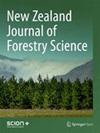生长在新西兰Northland的“Kawa”白杨(三角杨Marshall x P.yunnanensis Dode)的锯材和结构产品
IF 1.1
4区 农林科学
Q2 FORESTRY
引用次数: 0
摘要
背景:虽然白杨(Populus spp.)是世界许多地区木材加工部门的重要原材料来源,但在新西兰,它以生产不适合结构应用的劣质锯材而闻名。然而,具有相对较高木材密度的“卡瓦”杨无性系(三角杨马歇尔×云南杨多德)可以生产结构木材。这一点,再加上证明符合建筑规范的证据,将改善新西兰该物种的利用选择。方法:对新西兰Northland一个28年树龄的“Kawa”杨修剪林分的锯材转化和等级恢复进行量化。对90mmx45mm结构板的样品进行测试,以确定其机械性能和由此产生的强度等级。对硼防腐剂的保留率和渗透性进行了测量,以确定木材是否可以处理到新西兰建筑标准要求的水平。对取自树木内不同径向和垂直位置的无缺陷小试样进行密度、弹性模量和断裂模量评估,以确定这些特性的茎内和茎间变化。结果:原木转化为锯材的总转化率为53%,其中约94%的回收率由分级木材组成。降级最常见的原因是打结、修剪伤口和末端裂开。大约70%的锯木板被分级为透明木板,包层和结构板的回收率较小。净截面的平均长度约为2.5m。结构板的机械测试表明,它们的特征值足以满足SG10强度等级的要求。防腐处理达到H1.2规范。从原木外部切割的样本的密度、弹性模量和断裂模量都高于从木髓附近茎部以上所有高度切割的样本。结论:根据新西兰建筑规范,机械性能和硼处理结果表明适用于结构应用卡瓦白杨也产生了高品位的回收率,这表明其具有商业锯材生产的潜力,尤其是结构外观产品。本文章由计算机程序翻译,如有差异,请以英文原文为准。
Sawn timber and structural products from ‘Kawa’ poplar (Populus deltoides Marshall x P. yunnanensis Dode) grown in Northland, New Zealand
Background: While poplar (Populus spp.) is an important source of raw materials for the wood processing sector in many regions of the world, in New Zealand it has a reputation for producing poor grade recoveries of sawn timber that is unsuitable for structural applications. However, the ‘Kawa’ poplar clone (Populus deltoides Marshall x P. yunnanensis Dode), which has relatively high wood density, could yield structural timber. This, along with evidence demonstrating building code compliance, would improve utilisation options for this species in New Zealand.
Methods: Sawn timber conversion and grade recovery were quantified for a 28-year-old pruned stand of ‘Kawa’ poplar grown in Northland, New Zealand. A sample of 90 mm x 45 mm structural boards were tested to determine their mechanical properties and the resulting strength class. Boron preservative retention and penetration were measured to determine whether timber could be treated to the level required under New Zealand’s building standards. Density, modulus of elasticity and modulus of rupture were assessed on small defect-free specimens taken from different radial and vertical positions within trees to determine intra-stem and inter-stem variation in these properties.
Results: The overall conversion of logs to sawn timber was 53%, with approximately 94% of this recovery consisting of graded timber. The most common sources of downgrade were knots, pruning wounds, and end-splits. Approximately 70% of the sawn boards were graded as clears, with smaller recoveries of cladding and structural boards. The average length of clear section was approximately 2.5 m. Mechanical testing of structural boards demonstrated that they have characteristic values sufficient to meet the requirements for the SG10 strength class. Preservative treatment achieved the H1.2 specification. Density, modulus of elasticity and modulus of rupture were all higher in specimens cut from the outside of the log compared with those taken from near the pith at all heights up the stem.
Conclusions: Mechanical properties and boron treatment results indicate suitability for structural applications in accordance with New Zealand’s building code. ‘Kawa’ poplar also produced high grade recoveries suggesting potential for commercial sawn timber production, especially for structural appearance products.
求助全文
通过发布文献求助,成功后即可免费获取论文全文。
去求助
来源期刊

New Zealand Journal of Forestry Science
FORESTRY-
CiteScore
2.20
自引率
13.30%
发文量
20
审稿时长
39 weeks
期刊介绍:
The New Zealand Journal of Forestry Science is an international journal covering the breadth of forestry science. Planted forests are a particular focus but manuscripts on a wide range of forestry topics will also be considered. The journal''s scope covers forestry species, which are those capable of reaching at least five metres in height at maturity in the place they are located, but not grown or managed primarily for fruit or nut production.
 求助内容:
求助内容: 应助结果提醒方式:
应助结果提醒方式:


